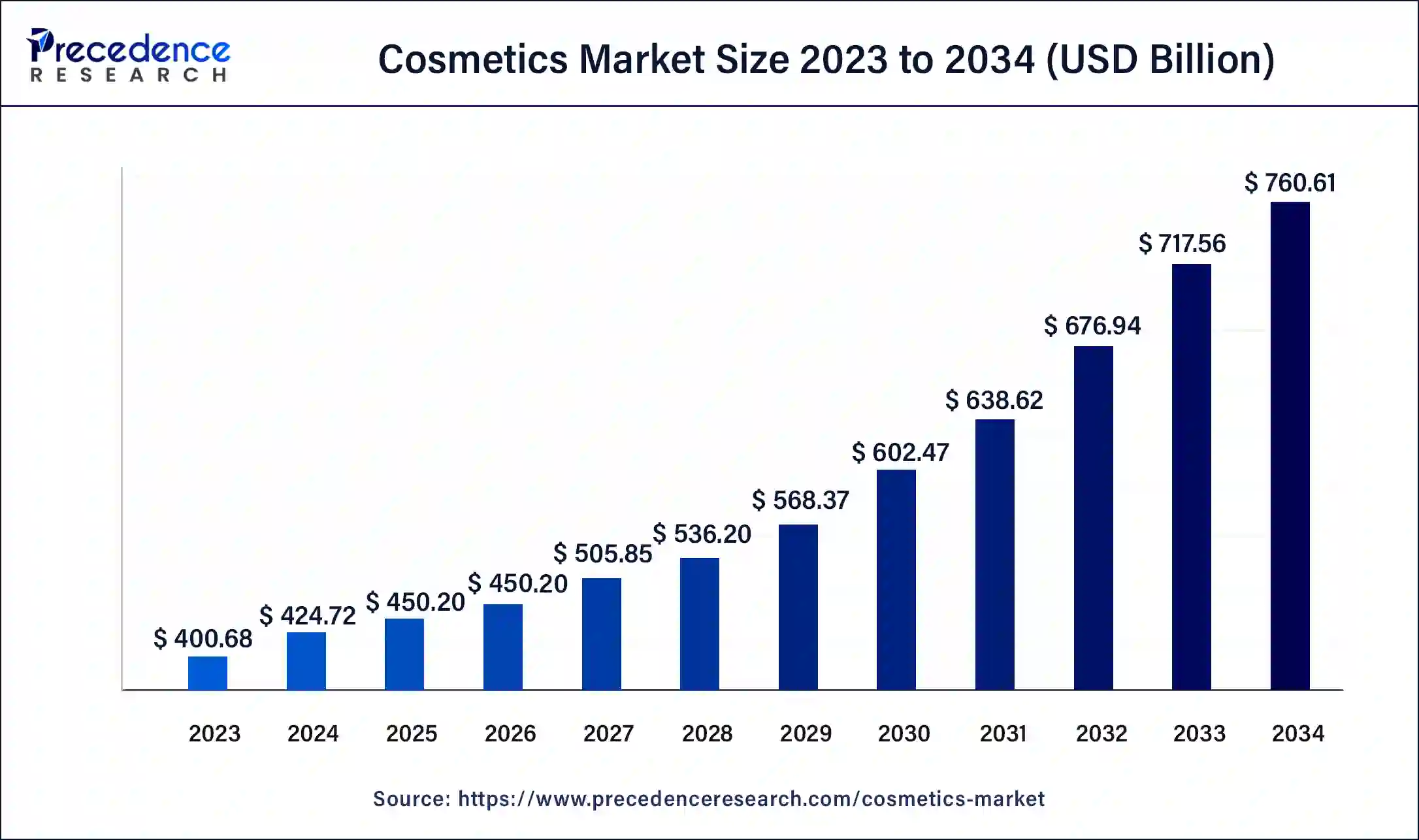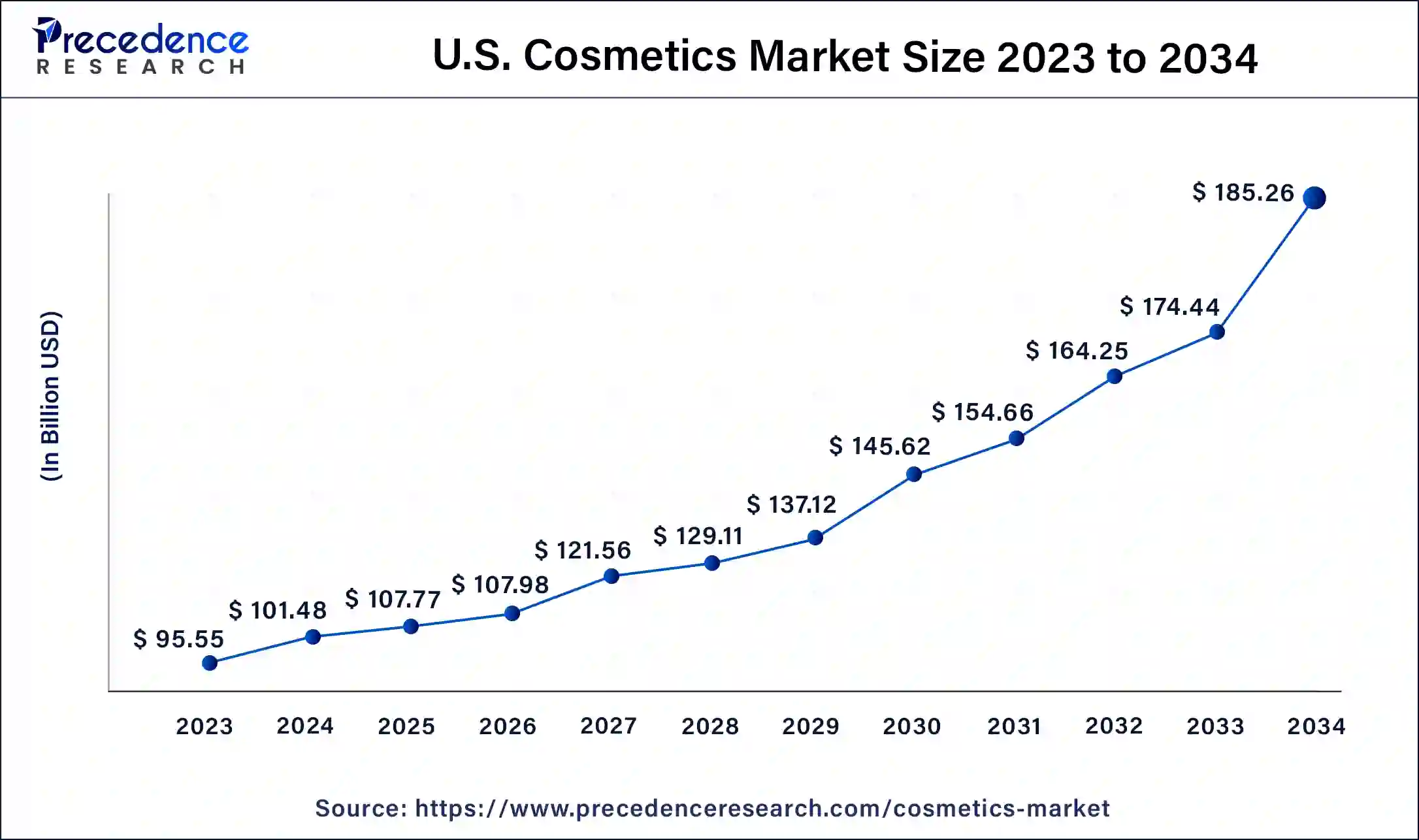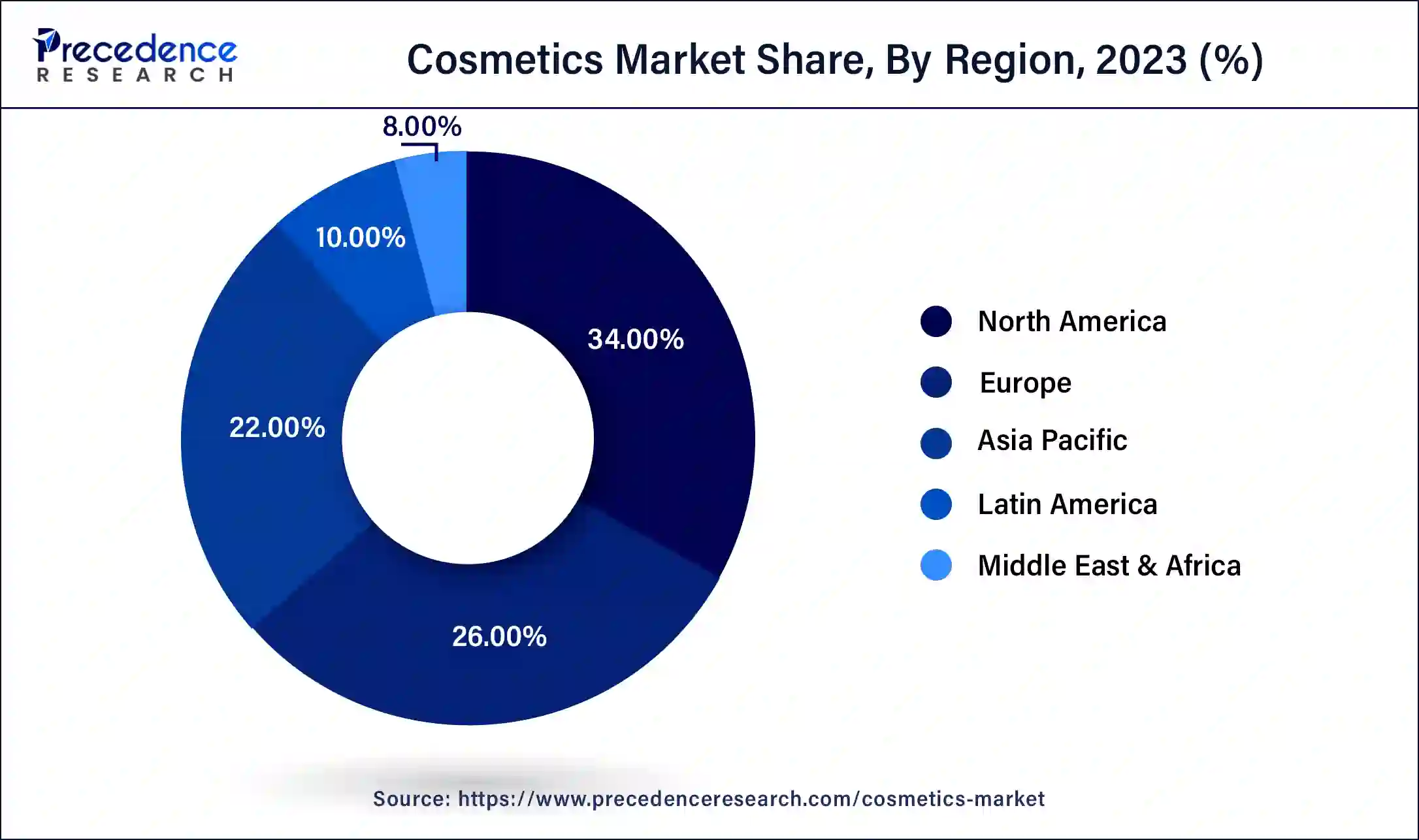November 2024
The global cosmetics market size accounted for USD 424.72 billion in 2024 and is predicted to increase from USD 450.20 billion in 2025 to approximately USD 760.61 billion by 2034, at a CAGR of 6% from 2025 to 2034.

The U.S. cosmetics market size was estimated at USD 101.48 billion in 2024 and is predicted to be worth around USD 185.26 billion by 2034, at a CAGR of 6.2% from 2025 to 2034.

The North America market holds the major share in the year 2024 and it expected to retain its dominant during the forecast period. The Asia-Pacific cosmetic market was valued at USD 88.15 billion in 2023 is expanding growth at a CAGR of 6% in the forecast period.
North America market is a mature market and it includes countries such as U.S., Canada and Mexico. Increase in population and improved lifestyle are the major factors that boost the growth of the cosmetics market. Raising purchasing power in this region is the prime factor which contributes towards the growth of the cosmetics market. Moreover, raising awareness amongst men’s regarding the personal grooming has further driven the sales of cosmetics products. Furthermore, unisex cosmetics products such as deodorants have become increasingly popular in this region owing to the associated benefits. This in turn further boosts the growth of the cosmetics market.

What Is Driving Growth in the European Cosmetics Market?
The European cosmetics market is expected to witness significant growth over the forecast period, due to the presence of innovation, sophistication among consumers, and a high cultural connection to fashion and beauty. The shopping experience is being transformed with the latest technological advancements, such as trying on virtual makeup. These tools enable consumers to make better buying decisions, which enhances interaction and improves sales of products. An increasing salon count, beauty schools, and fashion shows also contribute to product awareness and interaction with consumers.
How Is Sustainability Shaping Consumer Choices in Asia Pacific?
Asia Pacific held the largest market share in 2024. The consumers in the region are getting environmentally conscious, and the shift towards sustainable and natural beauty products is becoming serious. Green tea, rice, ginseng, aloe vera, and botanical extracts are some of the ingredients that the brands are using, and these ingredients are aligned with the holistic health practices and traditional remedies.
K-beauty (Korean) and J-beauty (Japanese) have transformed the whole cosmetics industry in the global market, where simplicity of skin care regimes, well-being, and discoveries are the ultimate priority. Among the key factors of sale are online shopping and social networks backed by influencer marketing and e-campaigns targeted at technology-savvy customers.
Rapid changing lifestyle across the globe is the major factor boosting the global cosmetics market. Moreover, changing climatic conditions in diversified region such as North America, Europe and Asia-Pacific and LAMEA has influenced the need for cosmetics and skin care products. Furthermore, the global per capita per income has observed a significant growth over the past few years especially in emerging countries. Rise in urbanization and growth of the middle class consumers in developed and developing region have encouraged the adoption of convenience oriented lifestyle and making cosmetics more desirable for all age group customers particularly amongst youngsters.
Moreover, raising demand for natural cosmetics products is the current trend in the market. Manufacturers like Patanjali, Emami, Loreal, Procter & Gamble Company, The Estee Lauder Companies Inc. and others are continuously indulged in producing herbal and natural ingredients cosmetics products. Furthermore, increasing awareness amongst male for personal grooming and hygiene has further boosted the growth of the market. Increasing in regressive promotions and advertisements through social media platforms such as Instagram, Facebook, YouTube and others by manufacturers has played a significant role in the growth of the market. However, Covid-19 has negatively impacted the global cosmetics market as implementation of lockdown and curfew practices were present globally. Moreover, supply chain restriction across the globe was the major which has restricted the growth of the market.
Furthermore, in the context of e-commerce growth, social commerce is significantly booming. The social commerce helps consumer to interact with brands or buying a product and service. Moreover, livestreaming has become a key social commerce tool in cosmetic world which significantly increased with the Covid-19 crisis. According, to Google almost 70% of millennials watch an online tutorial on YouTube during the Covid-19 crisis. In addition, online advertisement has significantly increased as it helps in better customer reach in lessor time.
| Report Coverage | Details |
| Market Size in 2025 | USD 450.20 Billion |
| Market Size in 2024 | USD 424.72 Billion |
| Market Size by 2034 | USD 760.61 Billion |
| Growth Rate from 2024 to 2034 | CAGR of 6% |
| Largest Market | North America |
| Base Year | 2024 |
| Forecast Period | 2025 to 2034 |
| Segments Covered | Category, Gender, Distribution Channel |
| Regional Scope | North America, APAC, Europe, Latin America, MEAN, Rest of the World |
Based oncategory, the cosmetics market is divided into skin and sun care products, hair care products, deodorants & fragrances, and makeup & color cosmetics. The skin care products and sun care products constitutes a major market share in during the forecast period. However, the hair care products are expected to grow at the highest CAGR.
Skin care is an umbrella term under which sun care, facial care, body care, hand care products fall under the same umbrella. Skin care products are majorly used by women as compared to men owing to the overall consciousness regarding their skin. Presently, manufacturers are using new technologies such as nanogold and nanosome technology or nano particles for producing new skin care products. These nanoparticles help in keeping the skin more young and provide safety against harmful ultraviolet rays.
Moreover, hair care segment of cosmetics products has reached to steady growth phase. Hair care products remain dynamic factor owing to its regular use by both men and women. Rising consumer preference towards spa’s and saloon for hairstyles creates addition demand for the hair care products.
On the basis on gender, the cosmetics market is categorized into men, women and unisex. The women segment in terms of market share and is projected to grow with a significant CAGR during the forecast period. Moreover, the cosmetics market across the globe has witnessed steady growth owing to increasing beauty consciousness among women. Furthermore, increase in young and female working population is further expected to boost the market growth.
Raising awareness regarding personal grooming amongst men further expected to drive the market. Moreover, increasing men’s preference towards herbal and natural cosmetics products is continuously rising which further augments the growth of the market.
By distribution channel, the cosmetics market is segmented into hypermarkets/supermarket, specialty stores, brand stores, convenience and online sales channel. Hypermarkets/supermarket is retail outlets that focus on selling a particular range and associated items. Hypermarkets/supermarket maintains considerable depth in the type of product that they specialize in selling premium prices products. Moreover, manufacturers are continuously making efforts to increase shelf visibility of their products and hence they are majorly targeting hypermarkets/supermarket stores. As a result, great variety of cosmetics products is available in this retail stores. Moreover, hypermarkets/supermarket stores provides great amount discount which result in attracting more and more customer, hence resulting in boosting the cosmetics market
By Category
By Gender
By Distribution Channel
By Geography
For inquiries regarding discounts, bulk purchases, or customization requests, please contact us at sales@precedenceresearch.com
No cookie-cutter, only authentic analysis – take the 1st step to become a Precedence Research client
November 2024
May 2025
May 2025
November 2024